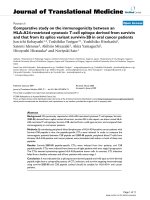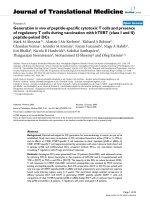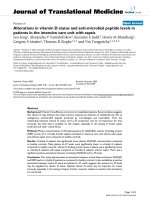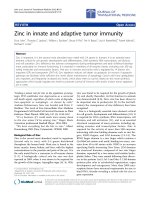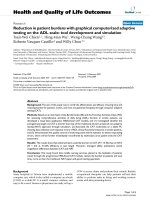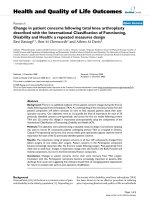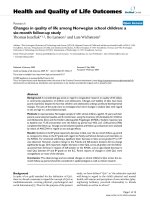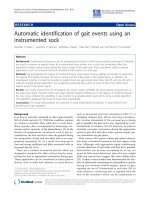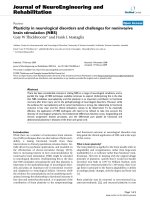Báo cáo hóa học: "Rumination in Bipolar Disorder: Evidence for an Unquiet Mind" docx
Bạn đang xem bản rút gọn của tài liệu. Xem và tải ngay bản đầy đủ của tài liệu tại đây (202.5 KB, 30 trang )
This Provisional PDF corresponds to the article as it appeared upon acceptance. Fully formatted
PDF and full text (HTML) versions will be made available soon.
Rumination in Bipolar Disorder: Evidence for an Unquiet Mind
Biology of Mood & Anxiety Disorders 2012, 2:2 doi:10.1186/2045-5380-2-2
Sharmin Ghaznavi ()
Thilo Deckersbach ()
ISSN 2045-5380
Article type Review
Submission date 13 July 2011
Acceptance date 23 January 2012
Publication date 23 January 2012
Article URL />This peer-reviewed article was published immediately upon acceptance. It can be downloaded,
printed and distributed freely for any purposes (see copyright notice below).
For information about publishing your research in Biology of Mood & Anxiety Disorders or any
BioMed Central journal, go to
/>For information about other BioMed Central publications go to
/>Biology of Mood & Anxiety
Disorders
© 2012 Ghaznavi and Deckersbach ; licensee BioMed Central Ltd.
This is an open access article distributed under the terms of the Creative Commons Attribution License ( />which permits unrestricted use, distribution, and reproduction in any medium, provided the original work is properly cited.
Rumination in bipolar disorder: evidence for an unquiet mind
Sharmin Ghaznavi
1*
and Thilo Deckersbach
1
1
Massachusetts General Hospital, Boston, MA, U.S.A
*correspondence to:
Sharmin Ghaznavi
Department of Psychiatry
Massachusetts General Hospital
15 Parkman St., WACC 812
Boston, MA 02114
SG
TD
Abstract
Depression in bipolar disorder has long been thought to be a state characterized by
mental inactivity. However, recent research demonstrates that patients with bipolar
disorder engage in rumination, a form of self-focused repetitive cognitive activity, in
depressed as well as in manic states. While rumination has long been associated with
depressed states in major depressive disorder, the finding that patients with bipolar
disorder ruminate in manic states is unique to bipolar disorder and challenges
explanations put forward for why people ruminate. We review the research on
rumination in bipolar disorder and propose that rumination in bipolar disorder, in both
manic and depressed states, reflects executive dysfunction. We also review the
neurobiology of bipolar disorder and recent neuroimaging studies of rumination, which is
consistent with our hypothesis that the tendency to ruminate reflects executive
dysfunction in bipolar disorder. Finally, we relate the neurobiology of rumination to the
neurobiology of emotion regulation, which is disrupted in bipolar disorder.
{Keywords: bipolar disorder, rumination, executive functioning, emotion regulation}
Review
Introduction
Bipolar disorder is characterized by episodes of mania or hypomania, with or
without one or more episode(s) of depression. By recent estimates, it affects between 1
and 2.5% of the general population in the United States [1]. Although mania/hypomania
is the distinguishing feature of bipolar disorder, recurrent depressive episodes constitute
the most frequent and functionally debilitating, unresolved aspect of the illness for indi-
viduals with bipolar disorder [2, 3]. For example, over their lifetime, patients with bipolar
disorder experience many more depressive episodes than manic or hypomanic
episodes and spend longer amounts of time depressed than manic or hypomanic [4, 5].
They are also more likely to consult a physician or psychiatrist for depression rather
than for mania [6]. Likewise, depressive episodes are associated with comparatively
greater occupational and psychosocial disruption then manic/hypomanic episodes. This
includes impairments at work [6, 7] as well as disruptions of patients’ family and social
life [6]. Unfortunately, despite the advancements in pharmacotherapy and the
emergence of adjunctive psychosocial treatments, the diagnosis and management of
bipolar depression remain significant challenges [8, 9].
Melancholic depression in bipolar disorder
One of the earliest observations about bipolar depression is that it is more likely
to be a melancholic depression. According to DSM-IV, the melancholic subtype is a
depressed state characterized by anhedonia, excessive weight loss, psychomotor
agitation or retardation, insomnia, worsening of symptoms in the morning, early morning
awakening and excessive guilt. Although operational definitions of melancholia have
varied over the years and across diagnostic systems (DSM III [10], DSMIII-R [11],
Research Diagnostic Criteria [12], the World Health Organization Depression Scale [13],
the Newcastle Scale – Versions I and II [13, 14], Hamilton Depression Rating Scale
[15]; see [16] for a review), the one consistent feature across the various definitions has
been that of psychomotor retardation [16], described as a slowed or decreased rate of
movement and/or speech.
In one of the early studies of the phenomenology of depressed states, Dunner
and colleagues [17] found that in the midst of a depressive phase, inpatients with
bipolar I disorder showed significantly less attention to personal appearance and
exhibited greater psychomotor slowing than inpatients with major depressive disorder
(MDD). Similarly, in a study looking at melancholic depression in patients who met
criteria for melancholic depression based on three different definitions, including DSM-
III, the rate of bipolar disorder was significantly higher than unipolar depression,
regardless of the definition of melancholia employed [18]. They also found that
melancholia was most clearly distinguished by psychomotor disturbance. Likewise, in a
study by Mitchell and colleagues [19] that compared bipolar I disorder patients with
patients with MDD, patients with bipolar disorder were found to be more likely to have
psychomotor retardation and atypical features (such as hypersomnia and leaden
paralysis) than depressed patients with MDD.
The generally held belief that patients with bipolar disorder (in particular bipolar I
disorder) are more likely to experience a melancholic depression characterized by
psychomotor retardation than patients with MDD, as well as the research showing that
melancholic depression is more common in bipolar I disorder, has led to the notion,
among clinicians, that there is a corresponding mental slowing as well [20, 21].
However, there have been no studies to suggest that patients with bipolar disorder are
less mentally active. The notion that there is mental slowing in bipolar depression may
also be, in part, a contrast to the large body of evidence that points to an active mind in
major depressive disorder, in the form of rumination.
Rumination in major depressive disorder
Major depressive disorder (MDD), sometimes referred to as unipolar depression,
is characterized by one or more episodes of depression, without any episodes of mania
or hypomania. Thus, it is nosologically distinguished from bipolar disorder by the
absence of hypomanic or manic episodes. One feature of MDD which has received
considerable attention is the tendency to ruminate [22], that is responding to negative
affect or depressed mood by focusing on self and symptoms of distress, without actively
engaging in active problem solving [23].
Rumination represents a behavioral and attentional style of responding to
negative affect or depressed mood. Thus, rumination is distinguished from such
problems as indecisiveness, as well as a set of recurrent thoughts about death and
suicide. Similarly, rumination is distinguished from dysfunctional attitudes, which are a
set of general beliefs about the self, world and future which are negatively biased, as
opposed to a means of responding to a negative affective stated. In fact, dysfunctional
attitudes are thought to be present in individuals at risk for depression when they are
euthymic (that is, not in a negative affective state).
By the same token, rumination is also distinguished from negative automatic
thoughts, which refers to a set of thoughts with distorted negative content. As Nolen-
Hoeksema originally pointed out, patient’s ruminative thoughts may often in fact be
realistic rather than distorted (for example, “I can’t complete my work on time.”) These
distinct features of rumination were demonstrated in early studies of rumination in which
participants were asked to state their responses to prompts in a rumination induction
paradigm developed by Nolen-Hoeksema and colleagues [24]. While it might be argued
that yet another difference between rumination and automatic thoughts is that there
seems to be a volitional component to a ruminative response style, whereas negative
automatic thoughts seem less volitional, such a characterization is oversimplified. As
discussed later, the cognitive underpinnings of rumination suggest that while a
ruminative response style may start off as seemingly volitional, its perpetuation may not
be volitional.
The tendency to ruminate is highly correlated to depressed mood (see [22] for a
review). To date, much of the research on rumination has been carried out on
individuals with dysphoria and patients with MDD [22]. Early studies on rumination
found that rumination can maintain or even worsen depressed mood [25, 26].
Additionally, the tendency to ruminate predicts the likelihood to go on to develop a first
major depressive episode following a stressor [23], as well as a worse prognosis in
patients with major depression. The tendency to ruminate was found to be predictive of
higher levels of depressed mood at discharge and follow-up after hospitalization in a
group of inpatients with MDD [27]. Studies on the phenomenology of rumination reveal
that it is a repetitive and persistent phenomenon that is difficult to stop and maladaptive
[28-30]. To date, there are no studies examining whether rumination is more prevalent
in certain types of depression (for example, excited depression or melancholic
depression); however, such research might illuminate differences in the phenomenology
of mood states in different types of depression.
Rumination is related to a negative self-concept in individuals with major
depression. In fact, in the course of their research on rumination, Nolen-Hoeksema and
Morrow [31] developed a rumination induction task, which consists of self-focused but
neutral statements, (for example, “think about the sensations in your body”). When
healthy normal controls are asked to engage in the task, they do not show any changes
in mood. However, when depressed individuals are asked to perform the same task,
they report maintenance or even worsening of depressed mood [31]. Presumably, self-
focus promoting statements activate negative self-schemata, which trigger
corresponding negative thoughts associated with maintenance or worsening of mood in
depressed patients, thereby creating a vicious cycle of increased self-focus, negative
thoughts and depressed mood.
Studies of negative thoughts and beliefs as assessed by two widely used and
well validated measures, the Automatic Thoughts Questionnaire (ATQ)[32] and
Dysfunctional Attitudes Scale (DAS) [33], show that negative automatic thoughts and
dysfunctional attitudes, often related to the self, are elevated in depressed states (ATQ:
[32, 34-37]; DAS: [33, 37-40]). This does not appear to be the case when patients are
euthymic (ATQ: [34, 37, 38]; DAS: [37-40]). A few studies have also found that
dysfunctional attitudes interact with negative life events, or stress, to predict depressive
symptoms [41, 42]. Thus, latent negative self-concepts, when activated, as in
rumination, may trigger depressed mood and relapse into depression.
Negative self-concept in bipolar disorder
There is an emerging literature documenting persistent negative self-concepts
(schemata) in individuals with bipolar disorder as well. In one study, using the ATQ and
DAS, Hollon et al. [37] found that regardless of nosology (MDD, bipolar disorder,
substance induced depression), among patients who were currently depressed, scores
on both the ATQ and DAS were higher than in other clinical and control groups.
Additionally, the ATQ covaried directly with levels of depression as measured by the
Beck Depression Inventory (BDI). In a study directly comparing scores on the DAS
between patients with bipolar disorder and patients with MDD, Jones and colleagues
[43] found that, when current levels of depression were taken into account, there was no
difference on scores on the DAS between the two groups. More recently Scott and
Pope [44] also found that patients with MDD and bipolar disorder did not differ
significantly on overall scores on the DAS. The finding that scores on the DAS and ATQ
do not differ between patients with MDD and bipolar disorder suggests that self-concept
in depressed states in both disorders is equally negative.
Consistent with this, Reilly-Harrington et al. [45] found patients with bipolar
disorder and MDD performed similarly on a Self-Referent Information Processing Task
[46] that consisted of a battery of four tasks which tap into self-attributes. Both groups
performed the tasks in a manner consistent with a negative self-concept.
Additionally, research on self-esteem suggests that patients with bipolar disorder
and major depression demonstrate similar low levels of self-esteem. In their study
comparing patients with bipolar disorder and MDD on the DAS, Scott and Pope [44]
also used the Rosenberg Self-Esteem Questionnaire (SEQ; [47]). The SEQ is a
measure of trait self-esteem consisting of five negative and five positive statements
(corresponding to negative and positive self-esteem respectively), which participants
rate on a 1 to 4 scale. They found that patients with bipolar disorder and MDD did not
differ significantly on overall scores on the SEQ. Similarly, in the Jones and colleagues
study [43], when current levels of depression were taken into account; there was no
difference on scores on the SEQ between depressed patients with bipolar disorder and
depressed patients with MDD, and both patient groups had significantly lower scores on
the SEQ than control participants.
Unique to bipolar disorder, scores on the DAS are elevated in patients with
bipolar disorder during the manic phase as well as the depressed phase. Goldberg and
colleagues [48] compared scores on the DAS in patients with bipolar disorder who were
manic, patients with MDD who were depressed, and controls. They found that while
patients with MDD, who were currently depressed, had the highest scores on the DAS,
patients with bipolar disorder who were manic, had significantly higher scores on the
DAS than healthy controls.
As in MDD, scores on the ATQ and DAS do not appear elevated when patients
with bipolar disorder are in remission. For example, in the study by Hollon and
colleagues [37], they found that scores on the ATQ and DAS were not elevated
compared to controls, in patients with bipolar disorder who were in remission. Likewise,
in a study by Lex and colleagues [49] investigating cognitive styles in patients with
bipolar disorder in full remission, there were no significant differences on scores on the
DAS and ATQ between patients with bipolar disorder who were in remission and
normal controls.
Finally, similar to patients with MDD, negative self-concept or schemata seem to
predict relapse into mania and depression in patients with bipolar disorder. In the study
by Reilly-Harrington and colleagues [45], scores on the DAS interacted with the number
of negative life events to predict increases in depressive, as well as manic, symptoms.
Depressed patients with bipolar disorder, who possessed greater dysfunctional attitudes
and experienced more negative life events, showed worsening in their mood symptoms,
both depressive and manic symptoms.
Rumination in bipolar disorder
While the bulk of the research on rumination has been conducted in
individuals with major depression, given the research showing negative self-
concept/schemata in bipolar disorder and the role of rumination or self-focus in
sustaining depressed mood one might expect that depressed patients with bipolar
disorder engage in ruminative thinking, similar to patients with MDD. Indeed, this is what
Johnson et al. [50] found in a recent study looking at the tendency to ruminate in
individuals with bipolar disorder, MDD and normal controls. They used the Response
Styles Questionnaire (RSQ; [51]), which is a measure of the tendency to engage in
ruminative responses when feeling depressed, and found that both individuals with
MDD and bipolar disorder endorsed heightened rumination in response to negative
affect, compared to normal controls.
Consistent with this, van der Gucht et al. [52] found that the tendency to ruminate
was highly correlated with depressive symptoms, (as assessed by the Hamilton
Depression Rating Scale; HDRS), in patients with bipolar disorder. In a recent study, in
our group with patients with bipolar disorder, using the RSQ, we also found that patients
with bipolar disorder, who are depressed, show a greater tendency to ruminate, when
compared to levels previously reported in normal controls [53].
Given the repetitive and persistent nature of ruminative thinking, its presence in
depressed states in patients with bipolar disorder is contrary to the widely held belief
that depression in bipolar disorder is characterized by mental slowing, decreased
mental activity, or a relative dearth of thought. Early studies of rumination in unipolar
depressed states, in which participants were asked to state their thoughts in response
to the prompts on the rumination task developed by Nolen-Hoeksema and colleagues,
demonstrate that individuals who ruminate are mentally quite active, with numerous
thoughts, albeit with a negative bias [24]. Patients with bipolar disorder in depressed
states ruminate and, as such, are mentally quite active, suggesting an unquiet mind in
depressed states in bipolar disorder as well.
Notably, melancholia and rumination are not necessarily contrasting phenomena.
As reviewed above, various definitions of melancholia exist, but generally these
definitions, including the current DSM-IV definition, encompass primarily physical
symptoms (for example, psychomotor disturbance). Thus, cognitive states in
melancholia are not well characterized. It is possible, given the greater depressive
symptom load in melancholic depression and the correlation between rumination and
depressive symptom load, that rumination is prevalent among individuals afflicted with
melancholia. Thus, rumination and melancholia are not necessarily contrasting
phenomena, and, in fact, it is likely that rumination is a key feature of melancholia, not
previously described.
What appears to be unique to bipolar disorder is that studies of rumination in
bipolar disorder reveal that not only do individuals with bipolar disorder ruminate in
response to negative affect in depressed states, they ruminate in response to positive
affect as well. In the study by Johnson et al. [50], individuals with bipolar disorder
endorsed ruminating in response to positive affect as well as negative affect, albeit with
a more positive focus. Using the Response to Positive Affect Questionnaire [54] which
assesses tendencies in responses to positive affect, Johnson and colleagues found that
individuals with bipolar disorder, who were hypomanic, endorsed a tendency to focus on
positive affective experiences and positive self-qualities. Thus, patients with bipolar
disorder engage in a positive ruminative style in response to positive affect in a
hypomanic state, as well as a negative ruminative style in response to negative affect,
in a depressed state. Notably, positive rumination is conceptually different from
grandiosity, which is defined as an inflated sense of self-esteem or believing that one
has special powers, spiritual connections or religious relationships. Ruminative thoughts
of a positive nature may often be realistic (for example, “I did a good job on a project at
work last week”, which describes a positive affective experience that is reality based).
Additionally, positive rumination is distinguished from flight of ideas by the fact that the
content of positive ruminations is organized around positive affective experiences and
qualities, and not random associations. Studies which record the content of positive
ruminations, as Nolen-Hoeksema and colleagues have done with negative rumination
[24], are needed to provide empirical support for these distinctions.
Surprisingly, the tendency to engage in rumination to negative affect may also be
associated with hypomania. In studies of college sample students [55, 56], scores on
the RSQ are found to be positively correlated with hypomanic traits (as assessed by the
Eckblad and Chapman’s Hypomanic Personality Scale; HPS [57]). Individuals who have
a tendency to focus on their symptoms of distress and negative self-qualities also
possess more hypomanic traits. Notably, in another study, van der Gucht et al. [52] did
not find a correlation between rumination (as assessed by the RSQ) and manic traits
(as assessed by the Bech-Rafaelson mania scale [58]) in patients with bipolar disorder.
Psychological accounts of why patients with bipolar disorder ruminate
Given the role of rumination in persistence of negative mood, the question arises,
why do depressed patients ruminate? One account that has been put forward to explain
rumination in unipolar depression by Papageorgiou and Wells [28] is that rumination is a
coping strategy. Papageorgiou and Wells found that patients identified advantages as
well as disadvantages to rumination, suggesting that they engage in rumination in part
because of a perceived benefit from rumination. The advantages cited by patients
included a sense of improved understanding of their depression and the causes of their
depression, and a sense of control over their symptoms and problem solving.
This account is likely applicable to patients with bipolar disorder who are
depressed. They may engage in rumination for reasons similar to their MDD
counterparts. However, such an account does not explain why rumination has been
associated with hypomania in patients with bipolar disorder as well. One possibility that
has been put forward to account for this finding [55] invokes the age old idea of the
manic defense to depression. On this account, the hypomania/mania is a coping
strategy just like rumination, so the correlation between hypomania and rumination
reflects that they are both coping strategies used by patients with bipolar disorder who
are struggling with depression. Support for this account comes from a recent study by
Goldberg and colleagues [48] showing that patients with bipolar disorder in a manic
phase endorse negative core beliefs, suggesting that the mania may be a means of
coping with the negative core beliefs. Another account (Wright and Lam, 2004) is based
on research that patients with bipolar disorder generally have higher expectations
(Johnson et al., 2009) and are goal attainment focused (Lam et al., 2004), but when
depressed, have greater difficulty realizing those expectations and goals. The account
proposes that this difficulty leads to a failure to achieve those expectations and goals in
depressed states, which in turn may lead to negative self-appraisal and rumination. A
final related hypothesis explaining the link between the tendency to ruminate and mania
in bipolar disorder is rooted in the possibility that individuals with mania may have
experienced more failures, as well as destructive complications, as a result of their
mania (as opposed to failures due to their depression). According to this account
(Mansell et al., 2005), hypomania/mania may have led to more failures and in turn may
lead to a greater likelihood to resort to self-blame, negative self-appraisal and
rumination.
One problem with these three psychological accounts is the finding from Johnson
and colleagues (2008) that patients with bipolar disorder engage in positive rumination
(that is, positive self-appraisal) in response to positive affect in a hypomanic state.
Similarly, Eisner and colleagues [59] found that there is a tendency to engage in
positive generalization, similar to positive rumination, in response to successes. An
account of why patients with bipolar disorder ruminate must take into account why they
ruminate in response to both negative and positive affect.
The tendency to ruminate in bipolar disorder and executive dysfunction
We propose that the link between the tendency to ruminate in manic and
depressed states in bipolar disorder reflects executive dysfunction in bipolar disorder.
Research on neuropsychological functioning in bipolar disorder reveals deficits in
several cognitive domains, including attention, learning and memory, and executive
functioning [60-63]. The executive dysfunction seen in bipolar disorder is present in
euthymic, depressed and manic states, suggesting that the executive dysfunction is not
state specific, but rather trait-like. In one study, investigating neuropsychological
functioning in bipolar patients in manic, depressed and euthymic mood states, Martinez-
Aran et al. [63] found that regardless of mood state, all patients with bipolar disorder
showed impaired functioning on tests of executive functioning, including the Wisconsin
Card Sort Task (WCST) and Stroop Color and Word Interference task. While a more
recent study calls into question the presence of executive dysfunction in euthymic states
in bipolar disorder, they nonetheless found a trend towards executive dysfunction in
patients with bipolar disorder who are euthymic [64]. It is possible that the executive
dysfunction present in patients with bipolar disorder in euthymic states is exacerbated in
mania and depression.
In fact, in studies using tests of executive functioning, including attentional set-
shifting [65, 66], planning ability [67] and decision making [66, 67], researchers
consistently find deficits in executive functioning in mania. And the finding by Martinez-
Aran et al. [63] of executive dysfunction in depressed states in bipolar disorder is
consistent with the literature showing executive dysfunction in depressed states in MDD
(see [68] for a review). Of note, many of the tasks used to assess executive functioning
are tasks which incorporate multiple executive processes (for example, the WCST
incorporates shifting attention as well as inhibition), so a fine grain approach to
executive functioning as suggested by Miyake et al. [69] is not currently possible.
However, such an approach would be invaluable at more precisely identifying particular
executive deficits in bipolar disorder. This highlights the need for research into specific
executive processes in bipolar disorder.
There is some initial evidence that the tendency to ruminate is associated with
executive dysfunction. In a study by Davis and Nolen-Hoeksema [70], individuals with a
tendency to ruminate were found to demonstrate perseverative tendencies and failures
to maintain adaptive cognitive sets on the WCST. Similarly, Watkins and Brown [71]
found that depressed patients who underwent a rumination induction and were asked to
perform a random number generation task showed failures of inhibitory executive
control compared to depressed participants who underwent distraction, and non-
depressed participants. More recently, Whitmer and Banich [72] found that individuals
with a tendency to ruminate have trouble inhibiting mental representations of previous
task demands when they switch their attention to new task demands. Thus, rumination
seems to be associated with executive dysfunction, particularly inhibitory executive
control. Of course, given the dearth of studies, further research into executive
functioning and rumination is much needed.
Taken together, the evidence for executive dysfunction in bipolar disorder and
the relationship between rumination and executive dysfunction suggests that the
tendency to ruminate may be symptomatic of executive dysfunction in bipolar disorder,
specifically inhibitory executive dysfunction. Patients with bipolar disorder may
experience an exacerbation in executive dysfunction when manic or depressed, which
may lead to a tendency to ruminate because of a failure to inhibit self-focused thoughts
of a positive or negative nature. This possibility invites investigation into the effects of
mood states on executive functioning and rumination in bipolar disorder.
Neural correlates of bipolar disorder and rumination
Research into neural correlates of bipolar disorder has increased dramatically in
the last few decades with advances in structural and functional neuroimaging. The data
for structural differences are somewhat mixed, with a few studies showing no
differences between individuals with bipolar disorder and healthy controls in prefrontal
regions [73-75] and amygdala [76], and other studies reporting differences in both
prefrontal regions [77-80] as well as amygdala [81-84]. Two recent meta-analyses using
region of interest analyses found no evidence of gray matter abnormalities [85, 86], but
more recently one meta-analysis study using voxel based morphometry (VBM), which
uses a whole brain technique, found reductions in grey matter in the rostral anterior
cingulate cortex and the right fronto insular cortex [87], while another meta-analysis
study, also using VBM, found reductions in grey matter in the anterior cingulate and
insula [88].
Functional neuroimaging studies comparing patients with bipolar disorder and
healthy controls consistently report differences in prefrontal cortices, with early studies
showing blood flow and/or metabolic abnormalities in overall frontal metabolism in
patients with bipolar disorder compared to healthy subjects [89-93], and later studies
suggesting more fine-tuned differences in activation in subgenual prefrontal cortex in
patients with bipolar disorder compared to healthy controls [94].
More recently, studies using functional Magnetic Resonance Imaging (fMRI)
while performing various tasks, such as presentation of emotional stimuli, the Stroop
task and the Go/No-Go, and memory encoding tasks, consistently find differences in
activation in prefrontal regions in patients with bipolar disorder across all mood states.
Studies have found differences in activation in dorsolateral prefrontal cortex (DLPFC;
BA9/46) [95, 96], left ventral prefrontal cortex (VLPFC; BA47) [97], rostral ventral
prefrontal cortex (VLPFC; BA10/47) [98], and orbital and medial prefrontal (BA 8/9)
cortices in patients with bipolar disorder who are euthymic [97]. One study found
differences in activation in left ventral prefrontal cortex (BA 10/47) in patients with
bipolar disorder who were manic as well as those who were depressed [98]. Functional
neuroimaging studies also consistently report differences in amygdalar activitation in
response to negative stimuli relative to healthy controls in patients with bipolar disorder
who are euthymic [95], depressed [99] and manic [100].
Additionally, there are two studies that suggest a link between activity in
prefrontal cortices and amygdala in bipolar disorder. Yuerglen-Todd et al. [95] found
that patients with bipolar disorder who are euthymic demonstrate a reduction in DLPFC
(BA 9/46) activation and an increase in amygdalar activation in response to fear faces,
relative to healthy controls. Ketter et al. [99] found that patients with bipolar disorder
who were depressed had decreased global prefrontal and paralimbic cortical
metabolism and increased metabolism in right amygdala, ventral striatum and thalamus.
Taken together, these two studies suggest that decreased functional activation in
prefrontal areas may reflect a loss of cognitive control or executive dysfunction, and a
failure of emotion regulation, which may in turn lead to increased amygdala activation.
Consistent with this, a recent meta-analysis of 65 fMRI studies in bipolar disorder by
Chen and colleagues [101] found evidence for fronto-limbic activation in bipolar
disorder, which was characterized by attenuated ventrolateral prefrontal cortex
activation across emotional and cognitive tasks and enhanced limbic activation with
emotional tasks.
In a recent review on the neurophysiology of emotion regulation, Phillips et al.
[102] conceptualized a model of emotion regulation consisting of a voluntary emotion
regulation system involving lateral prefrontal cortices (DLPFC and VLPFC) and an
automatic emotion regulation system involving medial prefrontal cortices (OFC,
subgenual ACC and medial dorsal PFC). The model is based on research in healthy
controls which demonstrates increased activity in lateral prefrontal cortices in tasks of
voluntary behavioral control to positive and negative stimuli (for example, suppressing
facial reactions to emotional stimuli), voluntary attentional control (in which participants
are directed to selectively attend to task-relevant emotional stimuli/inhibit distraction
from task-irrelevant emotional stimuli, for example) and voluntary reappraisal (for
example, decreasing negative affect from a negative stimulus); and increased activity in
medial prefrontal cortices in tasks of automatic behavioral control (for example,
decreased affect to emotional stimuli), automatic attentional control ( implicit direction of
attention to or away from emotional stimuli, for example, the Stroop task), and automatic
reappraisal (for example, implicit appraisal of novel contexts).
Phillips et al. [102] show that there is an overlap with the above findings in bipolar
disorder. They report mixed findings with regards to voluntary emotion regulation:
studies of voluntary attentional control show reduced activation in lateral PFC and
DLPFC regions, while studies of voluntary emotion regulation show greater activation in
those same areas. The literature on automatic emotion regulation in patients with
bipolar disorder is more consistent with studies of automatic attentional control showing
reduced activitation in ventromedial PFC in bipolar disorder compared to healthy
controls and studies of emotion regulation showing reduced activation within
ventromedial PFC. Thus, overall, while it is clear that more research on emotion
regulation in bipolar disorder is much needed, it is nonetheless apparent that there are
differences in bipolar disorder in brain regions that are involved in emotion regulation.
Compared to the research on neural substrates of bipolar disorder, the research
on neural substrates of rumination is relatively new. In fact, there have been less than a
handful of studies, most of them in the last few years. These studies suggest overlap
with brain regions implicated in affective dysregulation in bipolar disorder, including
anterior cingulate, DLPFC, OFC, as well as amygdala, suggesting a common neural
substrate for rumination and affective dysregulation in bipolar disorder. In one of the first
studies, which investigated the relationship between the tendency to ruminate and
amygdalar response to word stimuli, Siegle and colleages [103] found that in depressed
individuals, the tendency to ruminate was moderately correlated with sustained
amygdala activity following presentation of negative items.
Ray et al. [104] investigated the relationship between the tendency to ruminate
and cognitive reappraisal after emotional responses in a non-clinical sample. They
found that the tendency to ruminate was correlated with increases in amygdala
response, when participants were instructed to increase negative affect, and with
decreases in prefrontal regions, including anterior cingulate cortex and medial prefrontal
cortex, when participants were instructed to decrease negative affect. More recently,
Cooney et al. [105] looked at neural activity during a brief rumination induction, a
concrete distraction induction, and an abstract distraction induction in depressed
individuals and normal controls. They found that depressed individuals showed greater
activation in the OFC (BA 11), subegenual cingulate (BA25), and DLPFC (BA 9) than
normal controls during rumination compared to concrete distraction. Additionally,
depressed participants showed greater activity than healthy controls in the rumination
condition compared to abstract distraction in the amygdala, dorsal anterior cingulate
(BA 24), rostral anterior cingulate (BA 32), DLPFC (BA 46), posterior cingulate (BA 31),
and parahippocampus. More recently, Hamilton et al. found a correlation between the
depressive rumination in depressed patients correlated with resting state activity in
posterior cingulate and medial prefrontal cortices [106].
Notably, many of the brain regions implicated in bipolar disorder overlap with
regions implicated in rumination, namely prefrontal cortical areas, including the anterior
cingulate, DLPFC, and OFC, as well as the amygdala. The evidence for common neural
substrates in bipolar disorder and rumination, particularly in prefrontal cortical regions,
which are believed to be involved in executive functioning, is consistent with our
hypothesis that executive dysfunction may underlie the tendency to ruminate in bipolar
disorder. Patients with bipolar disorder may ruminate because they experience difficulty
inhibiting their persistent self-focus, once it has been initiated. The fact that prefrontal
brain regions implicated in bipolar disorder and rumination include regions involved in
automatic emotion regulation (ACC, OFC) and voluntary emotion regulation (DLPFC)
point to a common neural substrate for affective dysregulation as well. Thus, patients
with bipolar disorder, due to differences in functioning in prefrontal cortical regions may
experience difficulty inhibiting and regulating emotion, just as they have difficulty
inhibiting their persistent self-focus in response to positive or negative affect (that is,
rumination). In fact, rumination, more generally speaking, might be explained by
differences in functioning in prefrontal cortical regions and a deficit in inhibiting self-
focus. These hypotheses provide interesting lines of investigation that might be pursued
in future neuroimaging studies.
Conclusions and future directions
The mind in bipolar disorder, whether manic or depressed, is never quiet.
Patients with bipolar disorder struggle and tend to ruminate in depressed states, just like
their MDD counterparts. Unique to bipolar disorder is the finding that patients with
bipolar disorder ruminate about positive things in hypomanic and possibly manic states,
which raises several questions.
One question that arises is whether rumination contributes to worsening in
hypomanic or manic states [50]. Research on rumination in depressed states [22]
demonstrates that rumination maintains and even worsens depressed mood. However,
it is unclear whether rumination plays a role in exacerbating or maintaining hypomanic
or manic mood. On this point, Johnson et al. [50] not only found that patients with
bipolar disorder ruminate in response to positive affect, but that it was explained by
hypomanic symptoms. Also, Johnson and Tran [107] found that individuals with bipolar
disorder show an increased focus on goals and increased confidence during manic
states. Research is needed on the relationship between rumination in response to
positive affect and future hypomanic or manic episodes.
Another question which arises is why do patients with bipolar disorder ruminate
in response to positive affect? We know that in major depression, rumination begins
with a desire to problem solve [28], but then evolves into a vicious cycle of repetitively
focusing on one’s symptoms of distress and how they came to be. One possibility is that
rumination in response to positive affect is intended to maintain the positive mood.
Johnson et al. [108] assessed the tendency to ruminate in response to positive affect
using a measure which assesses the tendency to think about positive qualities of the
self, positive affective experiences, and favorable life circumstances that might amplify
the positive affect, and found that patients with bipolar disorder endorsed a greater
tendency to ruminate to positive affect. It seems possible that such thinking might be
geared towards maintaining a positive mood. However, research on the effects of
positive rumination on mood is needed. Additionally, research on the reasons why
people engage in positive rumination is also needed. It is also possible that patients with
bipolar disorder ruminate in response to positive affect because the prospect of reward
initiates a cycle of thinking which might maximize reward. Perhaps the positive affect
serves as a sort of reward, and sets in cycle a desire for additional reward.
Finally, related to our hypothesis that the tendency to ruminate reflects executive
dysfunction, there are several questions which warrant investigation. Is intact executive
functioning protective? Are patients with bipolar disorder with little or no executive
dysfunction less likely to ruminate in response to positive or negative affect? What are
the neural mechanisms underlying the failure to inhibit rumination? It may be that the
failure to inhibit rumination is simply a product of prefrontal dysfunction and an inability
to inhibit certain cognitive processes as needed. Alternatively, it is possible that deficits
in automatic and voluntary emotion regulation as posited by Phillips [102] perpetuates
the cycle of rumination by affecting prefrontal functioning. Thus, there are several
avenues of research related to rumination and bipolar disorder that have the potential to
inform our understanding of what contributes to and maintains mood states in bipolar
disorder.
Abbreviations
ATQ, Automatic Thoughts Questionnaire; BDI, Beck Depression Inventory; DAS,
Dysfunctional Attitudes Scale; DLPFC, dorsolateral prefrontal cortex; HDRS, Hamilton
Depression Rating Scale; HPS, Eckblad and Chapman’s Hypomanic Personality Scale;
MDD, major depressive disorder; RSQ, Response Styles Questionnaire; SEQ,
Rosenberg Self-Esteem Questionnaire; VBM, voxel based morphometry; VLPFC, left
ventral prefrontal cortex; WCST, Wisconsin Card Sort Task
Competing interests
SG and TD have no competing interests.
Authors’ contributions
SG and TD were involved in research for this manuscript and drafted the manuscript.
Both authors read and approved the final manuscript.
References
1. Merikangas KR, Akiskal HS, Angst J, Greenberg PE, Hirschfeld RM, Petukhova
M, Kessler RC: Lifetime and 12-month prevalence of bipolar spectrum
disorder in the National Comorbidity Survey replication. Arch Gen Psychiatry
2007, 64:543-552.
2. Dion GL, Tohen M, Anthony WA, Waternaux CS: Symptoms and functioning
of patients with bipolar disorder six months after hospitalization. Hosp
Community Psychiatry 1988, 39:652-657.
3. Coryell W, Andreasen NC, Endicott J, Keller M: The significance of past mania
or hypomania in the course and outcome of major depression. Am J
Psychiatry 1987, 144:309-315.
4. Judd LL, Akiskal HS, Schettler PJ, Endicott J, Maser J, Solomon DA, Leon AC,
Rice JA, Keller MB: The long-term natural history of the weekly symptomatic
status of bipolar I disorder. Arch Gen Psychiatry 2002, 59:530-537.
5. Judd LL, Akiskal HS, Schettler PJ, Coryell W, Endicott J, Maser JD, Solomon
DA, Leon AC, Keller MB: A prospective investigation of the natural history of
the long-term weekly symptomatic status of bipolar II disorder. Arch Gen
Psychiatry 2003, 60:261-269.
6. Calabrese JR, Hirschfeld RM, Frye MA, Reed ML: Impact of depressive
symptoms compared with manic symptoms in bipolar disorder: results of a
U.S. community-based sample. J Clin Psychiatry 2004, 65:1499-1504.
7. Kessler RC, Akiskal HS, Ames M, Birnbaum H, Greenberg P, Hirschfeld RM, Jin
R, Merikangas KR, Simon GE, Wang PS: Prevalence and effects of mood
disorders on work performance in a nationally representative sample of
U.S. workers. Am J Psychiatry 2006, 163:1561-1568.
8. Thase ME, Sachs GS: Bipolar depression: pharmacotherapy and related
therapeutic strategies. Biol Psychiatry 2000, 48:558-572.
9. Gijsman HJ, Geddes JR, Rendell JM, Nolen WA, Goodwin GM:
Antidepressants for bipolar depression: a systematic review of
randomized, controlled trials. Am J Psychiatry 2004, 161:1537-1547.
10. American Psychiatric Association. Task Force on Nomenclature and Statistics.,
American Psychiatric Association. Committee on Nomenclature and Statistics:
Diagnostic and Statistical Manual of Mental Disorders. 3rd edition. Washington,
D.C.: American Psychiatric Association; 1980.
11. American Psychiatric Association, American Psychiatric Association, Work Group
to Revise DSM-III: Diagnostic and Statistical Manual of Mental Disorders: DSM-
III-R. 3rd edition. Washington, DC: American Psychiatric Association; 1987.
12. Spitzer RL, Endicott J, Robins E: Research diagnostic criteria: rationale and
reliability. Arch Gen Psychiatry 1978, 35:773-782.
13. Bech P, Gram LF, Reisby N, Rafaelsen OJ: The WHO Depression Scale.
Relationship to the Newcastle Scales. Acta Psychiatr Scand 1980, 62:140-
153.
14. Roth M, Gurney C, Mountjoy CQ: The Newcastle rating scales. Acta Psychiatr
Scand Suppl 1983, 310:42-54.
15. Hamilton M: A rating scale for depression. J Neurol Neurosurg Psychiatry
1960, 23:56-62.
16. Rush AJ, Weissenburger JE: Melancholic symptom features and DSM-IV. Am
J Psychiatry 1994, 151:489-498.
17. Dunner DL, Dwyer T, Fieve RR: Depressive symptoms in patients with
unipolar and bipolar affective disorder. Compr Psychiatry 1976, 17:447-451.
18. Parker G, Roy K, Wilhelm K, Mitchell P, Hadzi-Pavlovic D: The nature of bipolar
depression: implications for the definition of melancholia. J Affect Disord
2000, 59:217-224.
19. Mitchell PB, Wilhelm K, Parker G, Austin MP, Rutgers P, Malhi GS: The clinical
features of bipolar depression: a comparison with matched major
depressive disorder patients. J Clin Psychiatry 2001, 62:212-216; quiz 217.
20. Potter WZ: Bipolar depression: specific treatments. J Clin Psychiatry 1998, 59
Suppl 18:30-36.
21. Goodwin FK, Jamison KR, Ghaemi SN: Manic-depressive Illness: Bipolar
Disorders and Recurrent Depression. 2nd edition. New York, N.Y.: Oxford
University Press; 2007.
22. Nolen-Hoeksema S, Wisco BE, Lyubomirsky S: Rethinking rumination.
Perspect Psycholog Sci 2008, 3:400-424.
23. Nolen-Hoeksema S: The role of rumination in depressive disorders and
mixed anxiety/depressive symptoms. J Abnorm Psychol 2000, 109:504-511.
24. Lyubomirsky S, Tucker KL, Caldwell ND, Berg K: Why ruminators are poor
problem solvers: clues from the phenomenology of dysphoric rumination. J
Pers Soc Psychol 1999, 77:1041-1060.
25. Morrow J, Nolen-Hoeksema S: Effects of responses to depression on the
remediation of depressive affect. J Pers Soc Psychol 1990, 58:519-527.
26. Nolen-Hoeksema S: Responses to depression and their effects on the
duration of depressive episodes. J Abnorm Psychol 1991, 100:569-582.
27. Kuehner C, Weber I: Responses to depression in unipolar depressed
patients: an investigation of Nolen-Hoeksema's response styles theory.
Psychol Med 1999, 29:1323-1333.
28. Papageorgiou C, Wells A: Metacognitive beliefs about rumination in
recurrent major depression. Cogn Behav Pract 2001, 8:160-164.
29. Watkins E, Baracaia S: Why do people ruminate in dysphoric moods? Pers
Indiv Differ 2001, 30:723-734.
30. Watkins E, Moulds M: Positive beliefs about rumination in depression—a
replication and extension. Pers Indiv Differ 2005, 39:73-82.
31. Nolen-Hoeksema S, Morrow J: Effects of rumination and distraction on
naturally occurring depressed mood. Cognition Emotion 1993, 7:561-570.
32. Hollon SD, Kendall PC: Cognitive self-statements in depression:
development of an automatic thoughts questionnaire. Cognitive Ther Res
1980, 4:383-395.
33. Weissman AN, Beck AT: Development and validation of the Dysfunctional
Attitude Scale. Paper presented at the Association for the Advancement of
Behavior Therapy, Chicago 1978.
34. Blackburn IM, Jones S, Lewin RJ: Cognitive style in depression. Br J Clin
Psychol 1986, 25:241-251.
35. Crandell CJ, Chambless DL: The validation of an inventory for measuring
depressive thoughts: the Crandell Cognitions Inventory. Behav Res Ther
1986, 24:403-411.
36. Eaves G, Rush AJ: Cognitive patterns in symptomatic and remitted unipolar
major depression. J Abnorm Psychol 1984, 93:31-40.
37. Hollon SD, Kendall PC, Lumry A: Specificity of depressotypic cognitions in
clinical depression. J Abnorm Psychol 1986, 95:52-59.
38. Dohr KB, Rush AJ, Bernstein IH: Cognitive biases and depression. J Abnorm
Psychol 1989, 98:263-267.
39. Hamilton EW, Abramson LY: Cognitive patterns and major depressive
disorder: A longitudinal study in a hospital setting. J Abnorm Psychol 1983,
92:173-184.
40. Reda MA, Carpiniello B, Secchiaroli L, Blanco S: Thinking, depression, and
antidepressants: Modified and unmodified depressive beliefs during
treatment with amitriptyline. Cognitive Ther Res 1985, 9:135-143.
41. Olinger LJ, Kuiper NA, Shaw BF: Dysfunctional attitudes and stressful life
events: An interactive model of depression. Cognitive Ther Res 1987, 11:25-
40.
42. Wise EH, Barnes DR: The relationship among life events, dysfunctional
attitudes, and depression. Cognitive Ther Res 1986, 10:257-266.
43. Jones L: Cognitive style in bipolar disorder. Br J Psychiatry 2005, 187:431-
437.
44. Scott J, Pope M: Cognitive styles in individuals with bipolar disorders.
Psychol Med 2003, 33:1081-1088.
45. Reilly-Harrington NA, Alloy LB, Fresco DM, Whitehouse WG: Cognitive styles
and life events interact to predict bipolar and unipolar symptomatology. J
Abnorm Psychol 1999, 108:567-578.
46. Alloy LB, Abramson LY, Whitehouse WG, Hogan ME, Tashman NA, Steinberg
DL, Rose DT, Donovan P: Depressogenic cognitive styles: predictive
validity, information processing and personality characteristics, and
developmental origins. Behav Res Ther 1999, 37:503-531.
47. Rosenberg M: Society and the Adolescent Self-Image. Princeton, N.J.: Princeton
University Press; 1965.
48. Goldberg JF, Gerstein RK, Wenze SJ, Welker TM, Beck AT: Dysfunctional
attitudes and cognitive schemas in bipolar manic and unipolar depressed
outpatients. J Nerv Ment Dis 2008, 196:207-210.
49. Lex C, Meyer TD, Marquart B, Thau K: No strong evidence for abnormal
levels of dysfunctional attitudes, automatic thoughts, and emotional
information-processing biases in remitted bipolar I affective disorder.
Psychol Psychother 2008, 81:1-13.
50. Johnson S, McKenzie G, McMurrich S: Ruminative Responses to Negative
and Positive Affect Among Students Diagnosed with Bipolar Disorder and
Major Depressive Disorder. Cognitive Ther Res 2008, 32:702-713.
51. Nolen-Hoeksema S, Morrow J: A prospective study of depression and
posttraumatic stress symptoms after a natural disaster: The 1989 Loma
Prieta earthquake. J Pers Soc Psychol 1991, 61:115-121.
52. Van der Gucht E, Morriss R, Lancaster G, Kinderman P, Bentall RP:
Psychological processes in bipolar affective disorder: negative cognitive
style and reward processing. Br J Psychiatry 2009, 194:146-151.
53. Deckersbach T, Hölzel BK, Eisner LR, Stange JP, Peckham AD, Dougherty DD,
Rauch SL, Lazar S, Nierenberg AA: Mindfulness-based cognitive therapy for
nonremitted patients with bipolar disorder. CNS Neurosci Ther 2011. Epub
ahead of print.
54. Feldman GC, Joormann J, Johnson SL: Responses to Positive Affect: A Self-
Report Measure of Rumination and Dampening. Cogn Ther Res 2008,
32:507-525.
55. Thomas J, Bentall RP: Hypomanic traits and response styles to depression.
Br J Clin Psychol 2002, 41:309-313.
56. Knowles R, Tai S, Christensen I, Bentall R: Coping with depression and
vulnerability to mania: A factor analytic study of the Nolen-Hoeksema
(1991) Response Styles Questionnaire. Br J Clin Psychol 2005, 44:99-112.
57. Eckblad M, Chapman LJ: Development and validation of a scale for
hypomanic personality. J Abnorm Psychol 1986, 95:214-222.
58. Bech P, Rafaelsen OJ, Kramp P, Bolwig TG: The mania rating scale: scale
construction and inter-observer agreement. Neuropharmacology 1978,
17:430-431.
59. Eisner LR, Johnson SL, Carver CS: Cognitive responses to failure and
success relate uniquely to bipolar depression versus mania. J Abnorm
Psychol 2008, 117:154-163.
60. Martinez-Aran A, Vieta E, Colom F, Reinares M, Benabarre A, Gasto C,
Salamero M: Cognitive dysfunctions in bipolar disorder: evidence of
neuropsychological disturbances. Psychother Psychosom 2000, 69:2-18.
61. Bearden CE, Hoffman KM, Cannon TD: The neuropsychology and
neuroanatomy of bipolar affective disorder: a critical review. Bipolar Disord
2001, 3:106-150; discussion 151-103.
62. Quraishi S, Frangou S: Neuropsychology of bipolar disorder: a review. J
Affect Disord 2002, 72:209-226.
